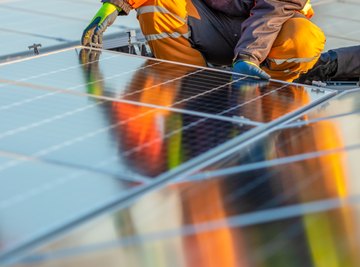
Global oil use is on the rise, even as scientists warn of depleting fossil fuel resources and an ever-growing greenhouse effect from burning these products. According to "The Homeowner's Guide to Renewable Energy" by Dan Chiras, the use of fossil fuels over available renewable resources is a relatively new development. Throughout history, human ancestors have used renewable energy as a source of power, and technology has now developed ways to harness renewable resources into electric energy for use in homes and businesses.
Solar Energy for Heat
Solar energy is a versatile and renewable source of energy. At its core, every source of energy, even fossil fuels, were originally powered by seemingly omnipresent solar energy. In the home, solar energy can be used to warm water for bathing or cleaning in the same way that solar bags are used among camping enthusiasts. They are filled with water and placed in the sun to warm, then attached to a solar shower and used as the source for shower water.
Solar Panels
Solar panels can be used to collect solar energy and turn it into electricity, and more and more they are used in homes. In fact, you may already have a garden lantern that is powered by a solar panel. When used as a major power source, solar panels are often quite large and may be mounted on the roof of a home. The solar energy collected is converted to electricity and can be used and stored, as with purchased electricity. Solar panels can also be used to charge batteries and perform smaller electric tasks as well.
Water
Water can also be used to gather electricity by hydroelectric power plants, which harness the flow of runoff water in rivers, streams and lakes. According to "The Citizen-Powered Energy Handbook," by Greg Pahl, there is great potential to use hydroelectric power in urban areas, where there is a constant flow of water through municipal pipes.
Harnessing Municipal Water
In the book, Pahl discusses how hydroelectric power can be used to harness the movement of renewable water through municipal water pipes, and how smaller hydroelectric power plants can harness the power of the water that flows through the pipes in your house. That power could supply a large or small power demand in your home and get better and cheaper as generators become smaller and less expensive to build. Water, though its volume on the Earth is finite, is considered to be a renewable resource, because conservation efforts in local areas can alleviate a water shortage.
Wind
A windmill is typically attached to a generator that is powered by its rotation: When the wind blows, its force turns the windmill. Wind energy was first used not to produce electricity, but to perform repetitive mechanical tasks, such as pump water from wells or to grind grain. Today, windmills can be used for a variety of situations, including when a small amount of power is needed. They can be used most places, as they can be made any size.
References
Resources
About the Author
Heather Bliss has been writing professionally since 1998, specializing in technology, computer repair, gardening, music and politics. Bliss holds an Associate of Arts in journalism from Moorpark College. She also has a Bachelor of Arts from California State University, San Marcos, completed with a focus on music and performing arts technology.
